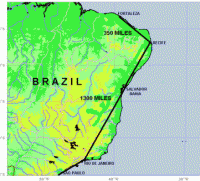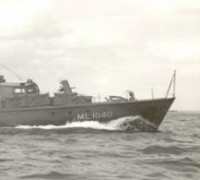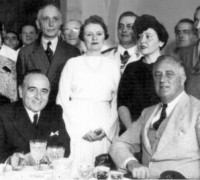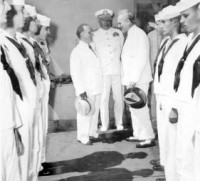MILITARY RELATIONS WITH BRAZIL BEFORE PEARL HARBOR - BRAZIL X USA MILITARY RELATIONS
1)BRAZIL X US BEFORE PEARL
The progress of navigation by air in the decade preceding World War II radically altered the framework of planning for the defense of the United States and the Western Hemisphere. Commercial airways bridged the 1,800 mile ocean span between Africa and Brazil and pointed out the Brazilian bulge as the air approach that an Old World aggressor would find most practicable.
The adoption of a new policy of hemisphere defense in November 1938 necessarily focused the attention of American military planners on Brazil. A hostile military lodgment in Northeast Brazil would have immediately threatened the meager existing Caribbean defenses of the United States to the north and, to the south, the most populous and highly developed region of South America.
In 1939 protection of the Brazilian bulge against Axis aggression became the keystone of American military plans for defending the hemisphere's Atlantic front. The Army was well aware that the successful execution of plans and measures to this end would require the friendly cooperation and collaboration of Brazil, and its staff discussions with Brazilian military authorities, which began in June 1939, eventually led to a full military partnership during World War II between the United States and Brazil.
Fortunately, a tradition of friendship existed between the United States of America and the United States of Brazil. Their relations had been particularly cordial in the preceding half century, during which their economies had become increasingly interdependent. Only Brazil among the South American nations became an active belligerent in World War I.
Brazilians had enthusiastically espoused the Pan-American concept from its beginnings and had worked in complete harmony with the United States in establishing the political framework of inter-American solidarity climaxed in 1938 by the Declaration of Lima. Brazil has nearly half the area and about half the population of the South American continent, and great natural resources make it one of the potentially strong powers of the world.
But in 1939 Brazil's military strength was no match for its size and natural wealth. The Brazilian Navy was so antiquated that both American and Brazilian experts considered it of little worth for action against modern naval vessels. The Army, which had an active strength of about sixty-six thousand in 1939, lacked modern combat equipment.
The Air Force, which was to be organized as an independent service in January 1941, had no modern combat planes and was far weaker than those of Argentina and Peru. Brazil's military policy called for the concentration of its Army in the populous southeastern part of the country, adjacent to the Argentine and Uruguayan borders and to the large Italian, German, and Japanese minorities in the southern states. These foreign elements--especially the Germans and Japanese--had been only partially integrated into Brazil's population, and during the 1930's the Nazi and Fascist regimes in Europe had fostered movements among the German and Italian minorities that threatened the security of the Brazilian Government.
In consequence of Brazilian military concentration in the south, the 2,500 mile coast line north of Rio de Janeiro was virtually defenseless in 1939. It had no installations whatsoever for coastal defense, no defenses against air attack, and almost no ground troops to fend off an invader.
Nor did it have any means of land communication--road or railway--with central and southern Brazil that would have permitted rapid deployment of Brazilian forces toward the northeast to resist an external attack. While a surface attack on Northeast Brazil was fairly unthinkable as long as friendly naval powers--Great Britain, France, and the United States--controlled the Atlantic, the development of airpower and of the airway across the South Atlantic made an air attack feasible.
Combined with a fifth-column movement among the foreign minorities in the south, such an attack could conceivably have brought a quick overthrow of the administration of President Getúlio Vargas and produced a situation gravely inimical to the national interests of the United States and of the other American nations. Analyzing the situation in March 1939, an Army War College group concluded that only the United States could provide forces that would be adequate to protect the Brazilian bulge. Brazilian civilian and military authorities readily acknowledged the defenselessness of Northeast Brazil.
The Minister of War, General Eurico Gaspar Dutra, and the Army Chief of Staff, General Pedro de Goes Monteiro, naturally wanted to mend the situation by building up the strength of the Brazilian Army. The Brazilian Army's objective, from 1939 onward, was to improve and increase its ground forces so that it could provide an adequate defense of the Brazilian bulge without American ground assistance.
But Brazil's meager industrial development and lack of accessible industrial raw materials (notably iron and coal) made it almost wholly dependent on foreign armament supplies. Therefore, the Army's objective could be attained only by securing large quantities of arms from abroad--either by obtaining deliveries on a big munitions order placed with the German Krupp works in 1938 or by securing an equivalent arms supply from the United States.
Throughout the pre-Pearl Harbor period the Brazilians realized that they had no real chance of adequately modernizing their naval and air arms, and they were therefore more willing to accept United States air and naval support than ground support in the defense of Northeast Brazil. Between 1939 and 1942 the fundamental issue in Brazilian-American defense planning was the method of conducting a ground defense of the Brazilian bulge against the threat of external attack.
The changed military situation of 1942 finally permitted a resolution of this issue in accordance with Brazilian desires. The United States and Brazilian Armies had maintained relations before 1939 through military attachés in Washington and Rio de Janeiro, and also through a four-man United States Military Mission that since 1934 had helped advise and instruct the Brazilian Army in coast defense, ordnance, and chemical warfare matters. A thirteen-man United States Navy mission served the Brazilian Navy in a similar capacity.
A more intimate relationship followed the visit of Foreign Minister Oswaldo Aranha to the United States in February 1939, during which the Department of State had arranged for him to discuss military matters with the Chief of Staff and the Chief of Naval Operations. As a result an official invitation was issued to the Chief of Staff designate, General Marshall, to visit Brazil.
General Marshall, accompanied by War Plans and Air officers, arrived in Rio de Janeiro on 24 May 1939. There he established a personal relationship with the Brazilian Chief of Staff. In mid June General Goes Monteiro accompanied General Marshall to the United States on a return visit. This exchange of visits laid the groundwork for subsequent Brazilian-American military collaboration.
Transcribed by Patrick Clancey – Hyper War Foundation



